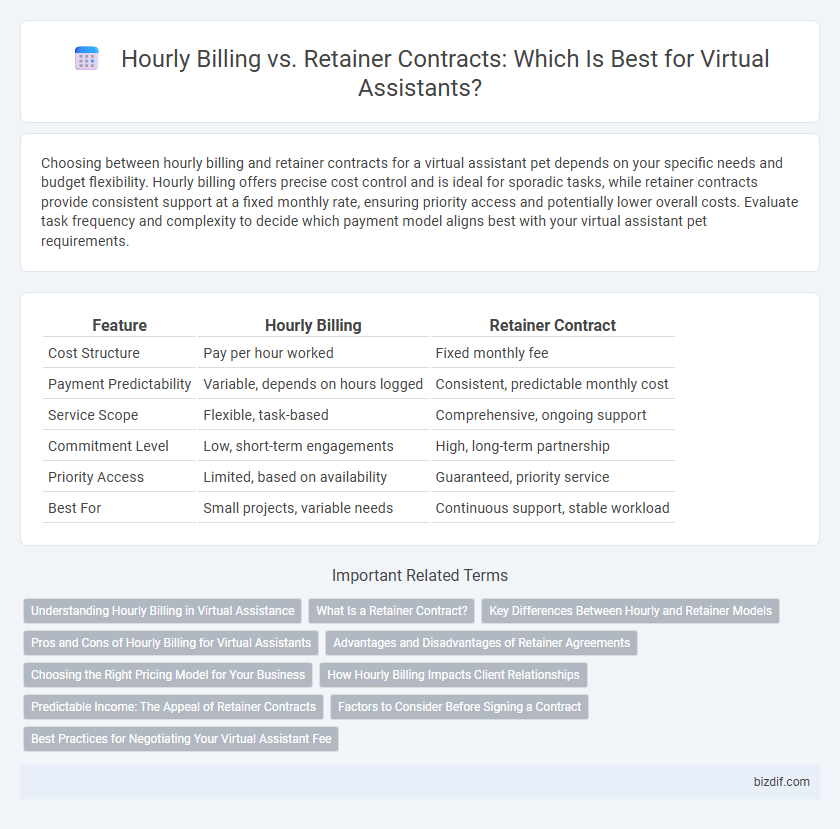Choosing between hourly billing and retainer contracts for a virtual assistant pet depends on your specific needs and budget flexibility. Hourly billing offers precise cost control and is ideal for sporadic tasks, while retainer contracts provide consistent support at a fixed monthly rate, ensuring priority access and potentially lower overall costs. Evaluate task frequency and complexity to decide which payment model aligns best with your virtual assistant pet requirements.
Table of Comparison
| Feature | Hourly Billing | Retainer Contract |
|---|---|---|
| Cost Structure | Pay per hour worked | Fixed monthly fee |
| Payment Predictability | Variable, depends on hours logged | Consistent, predictable monthly cost |
| Service Scope | Flexible, task-based | Comprehensive, ongoing support |
| Commitment Level | Low, short-term engagements | High, long-term partnership |
| Priority Access | Limited, based on availability | Guaranteed, priority service |
| Best For | Small projects, variable needs | Continuous support, stable workload |
Understanding Hourly Billing in Virtual Assistance
Hourly billing in virtual assistance involves charging clients based on the exact time spent on tasks, offering transparency and flexibility for varying workloads. This model suits projects with unpredictable scopes or short-term assignments, allowing precise tracking of hours through time management tools. Virtual assistants using hourly billing often provide detailed reports to justify costs and maintain clear communication on task progress.
What Is a Retainer Contract?
A retainer contract is an agreement where clients pay a fixed fee upfront to secure ongoing access to virtual assistant services over a specified period. This model ensures prioritized support and consistent availability, often leading to better budget predictability compared to hourly billing. Retainer contracts are ideal for businesses requiring regular, dependable assistance without the fluctuations of hourly charges.
Key Differences Between Hourly and Retainer Models
Hourly billing charges clients based on the exact time spent on tasks, providing flexibility and detailed tracking of work hours. Retainer contracts involve a fixed monthly fee for a predetermined scope of services, ensuring consistent availability and prioritized support. Key differences include billing predictability, client commitment level, and resource allocation efficiency between the two models.
Pros and Cons of Hourly Billing for Virtual Assistants
Hourly billing allows virtual assistants to charge clients based on actual time spent, offering flexibility and precise compensation for varied tasks. This method can lead to unpredictability in income and potential client concerns over escalating costs during longer projects. Managing hourly tracking diligently is essential to maintain transparency and foster trust in client relationships.
Advantages and Disadvantages of Retainer Agreements
Retainer agreements offer predictability in budgeting and prioritized access to virtual assistant services, providing a stable, ongoing partnership that encourages efficiency and deep understanding of client needs. However, these contracts may lead to underutilization if the allocated hours are not consistently used, potentially causing clients to pay for unused time. Retainers also limit flexibility, as clients commit to a fixed fee regardless of fluctuating workload demands, which can be a disadvantage for projects with irregular or unpredictable requirements.
Choosing the Right Pricing Model for Your Business
Selecting the right pricing model for your virtual assistant services depends on workload predictability and budget preferences. Hourly billing suits businesses with fluctuating tasks requiring flexibility, while retainer contracts provide steady support and cost savings for ongoing needs. Evaluating task volume, frequency, and long-term goals ensures alignment with either model, optimizing resource allocation and financial planning.
How Hourly Billing Impacts Client Relationships
Hourly billing creates transparency in service charges by allowing clients to see exactly how time is allocated to each task, fostering trust through clear accountability. This billing method can lead to fluctuating costs, which may cause uncertainty and affect long-term client commitment. Maintaining open communication and detailed time tracking helps manage expectations and strengthens the client-assistant relationship despite variable billing.
Predictable Income: The Appeal of Retainer Contracts
Retainer contracts offer virtual assistants predictable income by securing a fixed monthly fee regardless of hours worked, ensuring steady cash flow and financial stability. This model reduces the administrative burden of tracking billable hours, allowing focus on delivering consistent, high-quality service. Clients benefit from prioritized access and ongoing support, fostering long-term professional relationships.
Factors to Consider Before Signing a Contract
Evaluating workload predictability and project scope is crucial before choosing between hourly billing and a retainer contract for virtual assistant services. Assess the consistency of tasks and budget flexibility to determine if a fixed monthly fee or variable hourly rates better align with your operational needs. Consider the contract's terms regarding cancellations, scope changes, and availability to avoid future disputes.
Best Practices for Negotiating Your Virtual Assistant Fee
When negotiating your virtual assistant fee, emphasize value-based pricing by clearly outlining tasks and expected outcomes rather than just hourly rates. Use retainer contracts to establish steady, predictable income, ensuring both parties agree on workload and response times upfront. Transparency in communication and setting boundaries on hours or project scope optimizes satisfaction and minimizes disputes.
Hourly Billing vs Retainer Contract Infographic

 bizdif.com
bizdif.com